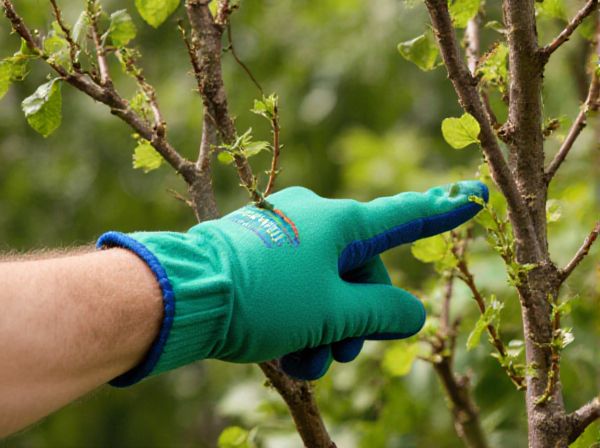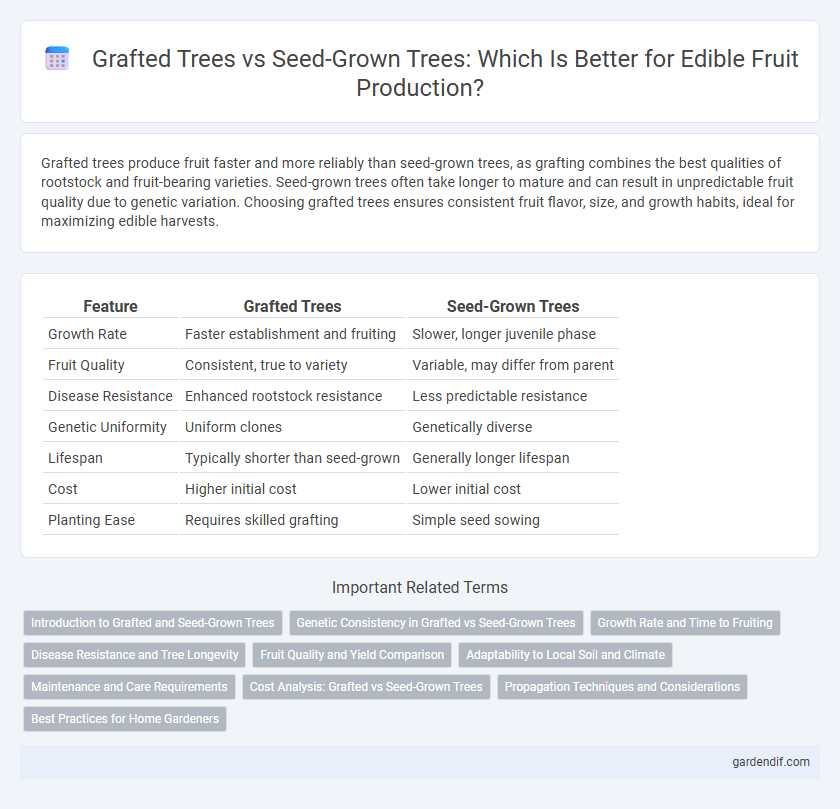
Grafted Trees vs Seed-Grown Trees Illustration
Grafted trees produce fruit faster and more reliably than seed-grown trees, as grafting combines the best qualities of rootstock and fruit-bearing varieties. Seed-grown trees often take longer to mature and can result in unpredictable fruit quality due to genetic variation. Choosing grafted trees ensures consistent fruit flavor, size, and growth habits, ideal for maximizing edible harvests.
Table of Comparison
| Feature | Grafted Trees | Seed-Grown Trees |
|---|---|---|
| Growth Rate | Faster establishment and fruiting | Slower, longer juvenile phase |
| Fruit Quality | Consistent, true to variety | Variable, may differ from parent |
| Disease Resistance | Enhanced rootstock resistance | Less predictable resistance |
| Genetic Uniformity | Uniform clones | Genetically diverse |
| Lifespan | Typically shorter than seed-grown | Generally longer lifespan |
| Cost | Higher initial cost | Lower initial cost |
| Planting Ease | Requires skilled grafting | Simple seed sowing |
Introduction to Grafted and Seed-Grown Trees
Grafted trees combine the rootstock of one tree with the desired fruit-bearing variety, ensuring uniformity and faster fruit production compared to seed-grown trees. Seed-grown trees develop from natural seeds, resulting in greater genetic variability and longer time to maturity. Understanding these differences is crucial for selecting the best tree type for orchard productivity and fruit quality.
Genetic Consistency in Grafted vs Seed-Grown Trees
Grafted trees exhibit genetic consistency by cloning the exact genotype of the parent tree, ensuring uniform fruit quality, size, and disease resistance across all propagated specimens. Seed-grown trees undergo genetic recombination, leading to variable traits and unpredictability in fruit characteristics and tree vigor. This genetic stability in grafted trees is crucial for commercial orchards seeking reliable crop outcomes and standardized edible produce.
Growth Rate and Time to Fruiting
Grafted trees typically exhibit a faster growth rate and reach fruiting maturity sooner than seed-grown trees, often producing fruit within 2 to 3 years compared to 5 to 7 years for seed-grown varieties. The grafting process combines a mature scion with a rootstock, allowing the tree to bypass juvenile stages and accelerate development. This method ensures earlier yield and more predictable fruit quality, making grafted trees preferable for commercial orchards and home growers seeking quicker harvests.
Disease Resistance and Tree Longevity
Grafted trees often exhibit enhanced disease resistance due to the careful selection of rootstocks genetically suited to combat common pathogens, contributing to improved tree longevity compared to seed-grown trees. Seed-grown trees tend to have more genetic variability, which can result in inconsistent resistance to diseases and generally shorter lifespans. The controlled propagation of grafted trees ensures uniformity in traits such as vigor and resilience, making them preferable for long-term orchard productivity and reduced susceptibility to infections.
Fruit Quality and Yield Comparison
Grafted trees consistently produce higher quality fruit with improved flavor, size, and texture compared to seed-grown trees, due to the preserved genetic traits of the selected rootstock and scion. Yield from grafted trees is typically more abundant and reliable, as grafting accelerates maturity and enhances disease resistance. Seed-grown trees often display greater variability in fruit quality and delayed productivity, making grafted trees the preferred choice for commercial fruit production.
Adaptability to Local Soil and Climate
Grafted trees exhibit higher adaptability to local soil and climate due to their genetically selected rootstocks, which enhance resistance to pests, diseases, and environmental stresses. Seed-grown trees may vary in adaptability because of genetic diversity, leading to inconsistent growth performance under specific local conditions. Selecting grafted trees tailored to regional requirements ensures more reliable fruit production and longevity in diverse environments.
Maintenance and Care Requirements
Grafted trees require more specialized maintenance due to the need for careful pruning to support the graft union and prevent disease, whereas seed-grown trees often develop stronger, more resilient root systems that demand less intensive care. Seed-grown trees may require less frequent watering and nutrient management, as their natural rootstocks are better adapted to local soil conditions. Regular monitoring for pests and diseases is critical in both methods, but grafted trees typically need closer attention to ensure the graft area remains healthy and stable.
Cost Analysis: Grafted vs Seed-Grown Trees
Grafted trees typically cost more upfront than seed-grown trees due to the precise horticultural techniques and labor required for grafting, but they offer earlier fruit production and increased disease resistance, which can lead to higher long-term profitability. Seed-grown trees are less expensive initially but often have unpredictable fruit quality and longer juvenile periods before bearing fruit, resulting in delayed returns on investment. Cost analysis favors grafted trees for commercial orchards seeking consistent yield and quality, while seed-grown trees might suit low-budget or experimental planting with tolerance for variability.
Propagation Techniques and Considerations
Grafted trees combine rootstock and scion to enhance disease resistance, fruit quality, and growth characteristics, allowing for faster fruit production compared to seed-grown trees, which require longer maturation. Propagation through grafting demands skillful union of compatible tissues to ensure vascular connection and long-term tree health. Seed-grown trees offer genetic diversity but vary in fruit quality and growth habits, making grafting the preferred technique for consistent, high-yielding edible orchards.
Best Practices for Home Gardeners
Grafted trees offer faster fruit production and more predictable fruit quality, making them ideal for home gardeners seeking early and consistent harvests. Seed-grown trees require longer maturation periods and may produce variable fruit characteristics, but they provide genetic diversity and resilience. Proper site selection, soil preparation, and regular pruning are essential best practices to ensure healthy growth and maximize yield in both grafted and seed-grown trees.
Grafted Trees vs Seed-Grown Trees Infographic

 gardendif.com
gardendif.com